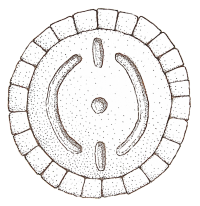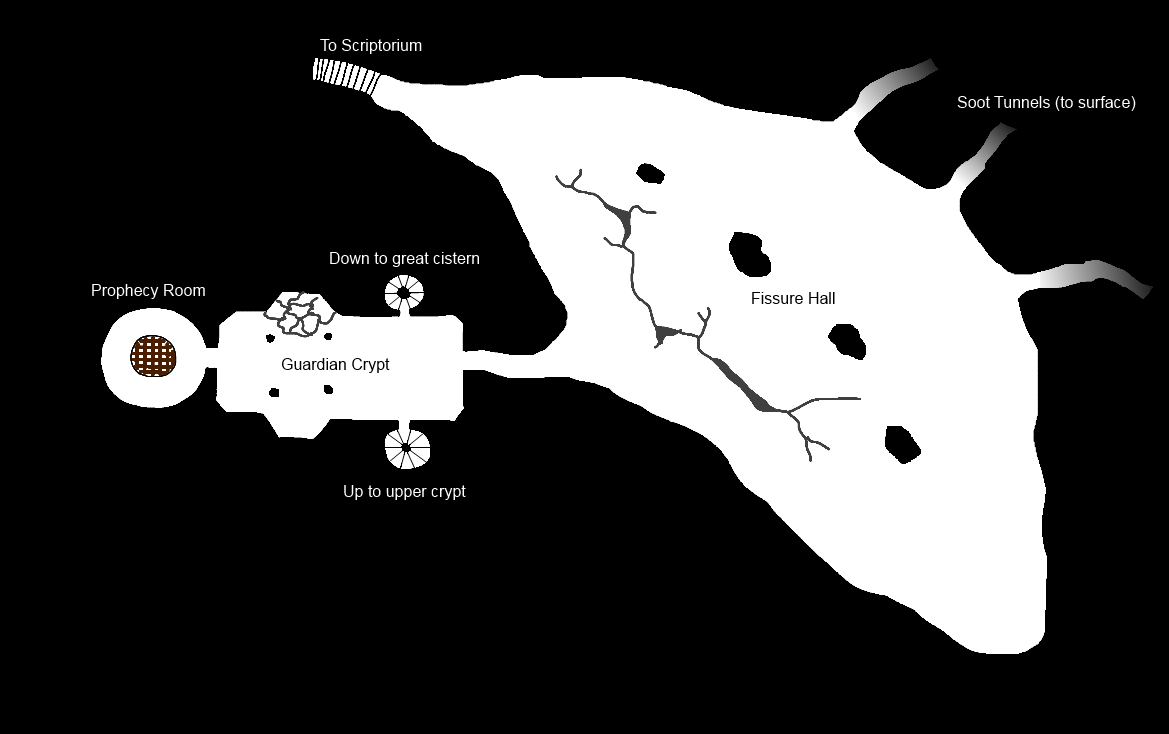Location: the Temple of Whispers
The Cliff
Nearly a third of the way up the Wall, a stone platform extends ~30 ft from the cliff face; here, the massive wooden doors of the Whispering Temple are set, sheltered by a slight overhang. A large stone stands at the end of the platform.
Switchbacking stone steps lead down to the plain below. They appear to have been used only a little by the Orcs, who preferred the Soot Tunnels, tight passageways which open on the base of the cliff, and access the Fissure Hall directly.
The Star Stone
A massive standing stone, carved with astronomical diagrams and large central hole for observing certain stars. Casts an odd shadow during daytime. Apparently untouched by the Defiler.
Upper Temple
Offering Hall
The first chamber of the Temple of Whispers is large, its high ceiling supported by rows of wooden columns. Large friezes on the walls, partly obscured by slime and soot, show scenes from the Tale of Seimar’s Sons. A large flat stone served to hold offerings (and the hideous rituals of the Defiler). This hall was badly damaged during the infiltration—a column has been blasted apart, and the ceiling partially collapsed.
Many archways line the walls, leading into the old treasury, the upper crypts, and the river room. A door in the northwest corner opens onto a spiral staircase, which leads to an old living area, mostly collapsed.
Old Treasury
This low-ceilinged hall was once closed off with heavy doors, but they are shattered. If any offerings were left when this place was abandoned, they are gone now, save for rot and debris.
The orcs used this chamber as a midden.
Upper Crypts
The central chamber here is a mortuary, holding a few biers where the dead would be prepared. Many niches line the walls, most sealed with clay plugs sculpted to resemble the dead. Some have been broken, revealing only heaps of dry bones.
One of these plugs, opened by the orcs (or even earlier?) concealed a spiral stair, which descends all the way to the Guardian Crypt in the Lower Temple. This stair was used heavily by the orcs.
River Room
This ritual chamber was once divided from the offering hall by two tapestries or shrouds. All that remains now is rotten tatters. A constant drizzle of water into the deep channel on the floor divides the room in two—a symbolic “river” to ritually cleanse any supplicants, and keep out unclean spirits. Possibly it has some magical properties.
Eight narrow passages lead out of the west side of the room into the labyrinth. This side seems totally unused by the orcs.
The infiltration team emerged from a well-concealed secret stair here. This hidden passage winds all the way up to a cistern near the top of the cliff, which they accessed by a wellshaft in the ceiling. Two sluices, labelled LOWER and RIVER, allow water to flow from this upper cistern, though the one labelled LOWER is stuck shut.
Labyrinth
A criss-crossing network of passageways, designed to test supplicants who sought the Idol Room. In places, the tunnels rise and fall; quite possibly they duck and climb over each other in places.
At each of the many forks is a wooden column carved with three faces, each looking towards on of the passages. One face is a man’s face, twisted with rage, with the tusks of a boar; the second a bearded man with gold eyes, the third a snake. A repeated pattern allows easy passage through the labyrinth—the angry head leads back to the River Room, but the Golden-Eyed head leads towards the Idol Room.
The Serpent heads seem to lead downwards and towards dead ends.
Idol Room
The dark, tight passages of the maze take one last sharp turn, and then open onto a well-lit, domed chamber.
An eternal flame burns at the center of the chamber (a bronze sun-sphere on a pedestal, no doubt the Idol of Shaulk). Stone and wooden Idols of the high gods and numberless lesser spirits line the chamber.
Dozens of iron-grated vents are set in the floor. Most likely, this chamber, placed somewhere above the Prophecy chamber, once had its own supply of the vision-inducing gas. In any case, the flow has stopped with the death of the Defiler.
In the far corner of the chamber, there is one odd statue set against the wall--a laughing scribe with two faces. It concealed a secret door to the Scriptorium.
Scriptorium
A natural cave, carved to serve the ancient priests as a library; a thousand scrolls rot here. Unlike the Labyrinth and the Idol Room, this chamber has been visited by the orcs--ransacked, in fact.
Lower Temple
Fissure Hall
A broad natural cave, with a ceiling supported by stacked stone pillars. There are gaps in the floor, and a watery chamber lies below. The sound of flowing water echoes through this hall.
Several small, crude tunnels lead out the eastern wall, towards the surface. The orcs used these to flood the battlefield with smoke, and to quickly pass between the lower temple and the surface.
A door in the west wall leads into the Guardian Crypt.
Lower Cistern
A huge, flooded chamber. The ceiling is supported by a few natural pillars, and heavy columns made of stacked stones. The sound of crashing water comes from the south side—perhaps it flows out into some deep cave.
Guardian Crypt
This room was once very grand, but a terrible battle has taken place here--the stone walls are scorched and melted, the north wall partly collapsed, and the shattered bodies of several ancient mummies litter the floor. From inscriptions on the walls here, these were likely high priests, set here to defend the tomb. They seem to have been defeated by the Defiler.
A cracked pedestal dominates the chamber, but there is nothing upon it. Most likely, it once held the Crystal Rod, which now lies down the shaft in the prophecy chamber.
The floor in the eastern section has been badly weakened, and is not far from collapsing into the cistern below.
An ancient door in the western wall allows access to the prophecy chamber.
Prophecy Chamber
A fairly small and simple circular chamber with a domed ceiling.
In the center is a wooden grate, composed of thick beams, covering a dark shaft 15 ft in circumference. Scorching hot gas once rose from the shaft, baking the body of the Defiler, but the flow seems to have stopped with his defeat. Vents in the ceiling carried the gas further upwards.
In all likelihood this was the true sanctum of the temple, where the favored druids divined the will of the gods. Perhaps in those days the flow of gas was weaker, or cooler; no living thing could survive the Defiler’s flow for long.



No Comments